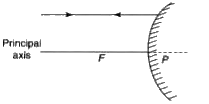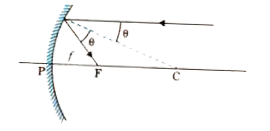Which of the following depend on whether rays are paraxial or not for spherical mirrors ?
Pole
Principal axis
Radius of curvature
Focus
The correct Answer is:D
To determine which of the options depend on whether rays are paraxial or not for spherical mirrors, we will analyze each option step by step.
Step 1: Understand the Definitions
- Pole: The pole of a spherical mirror is the center point of the mirror's aperture. It is a fixed point and does not change based on the nature of the incoming rays.
- Principle Axis: The principle axis is the line that connects the center of curvature and the pole of the mirror. This is also a fixed line and does not depend on the incoming rays.
- Radius of Curvature: The radius of curvature is the distance from the center of curvature to the pole. This value is constant for a given mirror and does not depend on the nature of the rays.
- Focus: The focus of a mirror is the point where parallel rays converge after reflection. This point can change depending on whether the rays are paraxial or not. If the rays are not paraxial, spherical aberration occurs, causing the rays to converge at different points rather than a single sharp focus.
Step 2: Analyze Each Option
- Option A: Pole - Does not depend on whether rays are paraxial or not.
- Option B: Principle Axis - Does not depend on whether rays are paraxial or not.
- Option C: Radius of Curvature - Does not depend on whether rays are paraxial or not.
- Option D: Focus - Depends on whether rays are paraxial or not due to the effects of spherical aberration.
Conclusion
The only option that depends on whether the rays are paraxial or not is Option D: Focus.
- Pole: The pole of a spherical mirror is the center point of the mirror's aperture. It is a fixed point and does not change based on the nature of the incoming rays.
- Principle Axis: The principle axis is the line that connects the center of curvature and the pole of the mirror. This is also a fixed line and does not depend on the incoming rays.
- Radius of Curvature: The radius of curvature is the distance from the center of curvature to the pole. This value is constant for a given mirror and does not depend on the nature of the rays.
- Focus: The focus of a mirror is the point where parallel rays converge after reflection. This point can change depending on whether the rays are paraxial or not. If the rays are not paraxial, spherical aberration occurs, causing the rays to converge at different points rather than a single sharp focus.
- Option A: Pole - Does not depend on whether rays are paraxial or not.
- Option B: Principle Axis - Does not depend on whether rays are paraxial or not.
- Option C: Radius of Curvature - Does not depend on whether rays are paraxial or not.
- Option D: Focus - Depends on whether rays are paraxial or not due to the effects of spherical aberration.
The only option that depends on whether the rays are paraxial or not is Option D: Focus.
Topper's Solved these Questions
- RAY OPTICS AND OPTICAL INSTRUMENTSBOOK - MODERN PUBLICATIONCHAPTER - RAY OPTICS AND OPTICAL INSTRUMENTSEXERCISE - OBJECTIVE TYPE QUESTIONS (B. MULTIPLE CHOICE QUESTIONS)
21 Videos
- RAY OPTICS AND OPTICAL INSTRUMENTSBOOK - MODERN PUBLICATIONCHAPTER - RAY OPTICS AND OPTICAL INSTRUMENTSEXERCISE - OBJECTIVE TYPE QUESTIONS (JEE (MAIN) & OTHER STATE BOARDS FOR ENGINEERING ENTRANCE)
40 Videos
- RAY OPTICS AND OPTICAL INSTRUMENTSBOOK - MODERN PUBLICATIONCHAPTER - RAY OPTICS AND OPTICAL INSTRUMENTSEXERCISE - Revision Exercises (Numerical Problems)
36 Videos
- NUCLEIBOOK - MODERN PUBLICATIONCHAPTER - NUCLEIEXERCISE - CHAPTER PRACTICE TEST FOR BOARD EXAMINATION
15 Videos
- SEMICONDUCTOR ELECTRONICS METERIALS DEVICES AND SIMPLE CIRCUITS BOOK - MODERN PUBLICATIONCHAPTER - SEMICONDUCTOR ELECTRONICS METERIALS DEVICES AND SIMPLE CIRCUITS EXERCISE - CHAPTER PRACTICE TEST FOR BOARD EXAMINATION
12 Videos
Similar Questions
Knowledge Check
Which of the following entities related to spherical mirrors do not depend on whether rays are paraxial or not ?
APoleBPrincipal axisCRadius of curvatureDfocal lengthWhich of the following correctly depicts the reflection of a ray of light on a spherical mirror?
A B
B C
C D
D

Rays parallel to principal axis, incident on the spherical mirror at different heights from principal axis are focused at different points. And due to this reason we cannot define unique focus. This is known as spherical aberration. Angle of incidence θ shown in figure depends on the height of ray above principal axis. Focal length of spherical mirror can be easily written in terms of angle θ shown in figure as follows :
f=R−R2secθ
Here R is radius of curvature of mirror. The light rays which are very close to principal axis are known as paraxial rays and rays far away from principal axis are called marginal rays.
Let fP and fm represent the focal length corresponding to paraxial rays and marginal rays respectively thenALet fp and fm represent the focal length corresponding to paraxial rays and marginal rays respectively thenBfp=fmCfp>fmDfp<fm
Plane Mirror||Spherical Mirror
View SolutionCan a plane mirror be called spherical mirror?
View Solution
Rays parallel to principal axis, incident on the spherical mirror at different heights from principal axis are focused at different points. And due to this reason we cannot define unique focus. This is known as spherical aberration. Angle of incidence θ shown in figure depends on the height of ray above principal axis. Focal length of spherical mirror can be easily written in terms of angle θ shown in figure as follows :
f=R−R2secθ
Here R is radius of curvature of mirror. The light rays which are very close to principal axis are known as paraxial rays and rays far away from principal axis are called marginal rays.
For paraxial rays focal length is approximately
View Solution
Rays parallel to principal axis, incident on the spherical mirror at different heights from principal axis are focused at different points. And due to this reason we cannot define unique focus. This is known as spherical aberration. Angle of incidence θ shown in figure depends on the height of ray above principal axis. Focal length of spherical mirror can be easily written in terms of angle θ shown in figure as follows :
f=R−R2secθ
Here R is radius of curvature of mirror. The light rays which are very close to principal axis are known as paraxial rays and rays far away from principal axis are called marginal rays.
What will be the focal length for ray which is incident at an angle 60∘?
View SolutionWhich of the following statements are incorrect for spherical mirror.
View Solution
